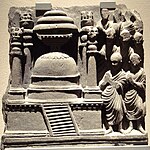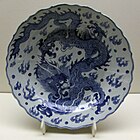Museum of Asian Art
 Exterior of the museum | |
| Established | In 2006 after merging with original Museum of East Asian Art |
|---|---|
| Location | Berlin City Palace, Mitte, Berlin, Germany |
| Coordinates | 52°31′03″N 13°24′10″E / 52.51750°N 13.40278°E |
| Type | Ethnological |
| Website | Museum of Asian Art |
The Museum of Asian Art (German: Museum für Asiatische Kunst) is a part of the Humboldt Forum in Berlin since 2020. Before its relocation it was sited in the neighborhood of the borough of Steglitz-Zehlendorf, Berlin, Germany. It is one of the Berlin State Museums institutions and is funded by the Prussian Cultural Heritage Foundation. It houses some 20,000 Asian artifacts, making it one of the largest museums of ancient Asian art in the world.[1] The museum is located in the same building as the Ethnological Museum of Berlin. The museum houses important collections of Art houses of South, Southeast and Central Asian countries and art from the Indo-Asian cultural area, from the 4th millennium BC to the present. Its geographic reach covers regions in India, Pakistan, Afghanistan, Sri Lanka, Bangladesh, Nepal, the Autonomous Region of Tibet and Xinjiang of the People's Republic of China, the Southeast Asian countries of Myanmar, Thailand, Cambodia, Vietnam, and also the Indonesian Islands or archipelago.[2]
History
[edit]The collection originally belonged to the Ethnological Museum of Berlin founded in 1873.[3] From 1904 it was known as the "Indian Department".

On November 8, 1906, by government decree, Wilhelm von Bode, director-general of the Royal Museums of Berlin, founded the collection of the Museum of East Asian Art in Berlin.[4] Germany's oldest museum of its kind, it was first located on Museum Island.
As a result of the four German Turfan expeditions, from 1902 to 1914, the collection was expanded to include Central Asia. In 1924, the exhibition was moved into the building belonging to the Arts and Crafts Museum, which at that time was also home to the Museum of Pre- and Early History (since 1981, it has been known as Martin-Gropius-Bau). The Society for East Asian Art founded in 1926 has provided substantial support for the museum's work. Thanks to their consistent expansion until the Second World War, the collections were among the most important in the world.
During the Second World War, there were regrettable losses, partly due to damage to the museum building and partly to the removal of a large number of artifacts to Russia.[1] After the war, the Red Army took about 90 percent of the distributed collections to the Soviet Union as war booty. There they were taken to the Hermitage in St Petersburg where they have remained until today. Only a few pieces were returned to Berlin. The almost complete loss necessitated recreating the collection but this could only be achieved gradually. From 1952, it was the Pergamon Museum that exhibited East Asian Art. At the instigation of the first director, Herbert Härtel, the collections were presented as part of an independent "Indian Art Department", later called the "Museum of Indian Art" (from 1 January 1963 to 4 December 2006).[1]
After the Berlin Wall went up, it was decided in 1970 to build new exhibition premises in West Berlin in the Zehlendorf district. After the fall of the Berlin Wall and German reunification, efforts were made to reorganize Berlin's museum scene. In 1992, the two separate collections were brought together in Dahlem. The Association of Friends of the Department, the Society of Indo-Asian Art Berlin eV, was founded in 1993. It publishes the annual Indo-Asiatische Zeitschrift ("Indo-Asian Journal"). In 2000, they were extended, forming until 2006 the Museum of East Asian Art, which now continues as the East Asian Art Collection at the Museum of Asian Art, since December 2006[5]
Collection
[edit]The collection covers the art of all of South Asia, Southeast Asia, and Central Asia, with special focus on sculpture (south and southeast Asia) and murals (central Asia). The artifacts date from the third millennium BC to the present day.[5]
The permanent exhibition contains stone, bronze, stucco and ceramic sculptures and stone reliefs with Hindu, Buddhist and Jain subjects as well as murals, clay sculptures and textiles from Buddhist complexes on the northern Silk Road (now Xinjiang, PR China), and Indian miniatures and craftwork from the Islamic Mughal period. Sculptures of stone, bronze and wood, as well as ritual objects from Nepal, Tibet, Burma, and southeast Asia complete coverage of the Indo-Asian region.[6] Special sections include the Gandhara Art Collection (Pakistan and Afghanistan, 1st-5th centuries) and a replica of a Central Asian Buddhist cave with a large section of the original.[7] The Gandhara art displays include artifacts from the Swat Valley.[8]
The museum, with an outstanding collection of some 20,000 artifacts, has example of stone sculptures, reliefs, bronze and terracotta works representative of Hinduism, Buddhism, and Jainism. Much of its collection of Jain art and Hindu sculpture dates to the classic period or the Middle Ages, and the museum also contains reconstruction of Indian temples.[1] The East Asian Art Collection houses the largest and most important collection of Chinese, Korean and Japanese art in Germany.[5] It consists of some 13,000 artefacts from all cultural periods, from the Neolithic to the present day. The three countries of the Asian subcontinent are first presented separately in their own departments. Their galleries converge on a central hall exhibiting the art of Buddhism, a common element in all three cultures. The Chinese Department has a large exhibition of porcelain, considerably enriched by Georg Weishaupt's collection, as well as lacquerware. Over 3,000-year-old bronzes, jades and ceramics attest to the country's early civilization and culture. A porcelain cup from the Wanli Emperor's time (1573–1620) during the Ming dynasty is of outstanding cultural and historical significance. In a separate room, a 17th-century traveling throne belonging to the Kangxi Emperor is exhibited.[9] Its unique rosewood screen has rich pearl inlays with decorations of gold and lacquerwork.
With selected examples its China-Japan gallery, the museum presents the art of writing, common to all areas of East Asian art. As many works of Chinese and Japanese writing and some of the old paintings are particularly sensitive to light, they are exhibited for periods of three months before being replaced. The same applies to many items of lacquerwork and textile art. However, as a result of ties with Japanese woodcuts and the museum's important graphic collection, new relationships and priorities constantly emerge. In the Japanese department, visitors are shown a Japanese tea room or Boki.[9] A study collection offers interested museum visitors the opportunity to experience an in-depth insight into the collection. A central repository for the collections is being planned in Berlin Friedrichshagen.
Services
[edit]By appointment the Japanese tea ceremony can be observed. A reference library is open exclusively to experts. An interactive computer program and alternating short films complement the presentation. The courtyard, which can be reached from the basement, presents a stone copy of the east gate of the famous Stupa I from Sanchi in central India.
Associations
[edit]A tradition of close cooperation exists with the German Society for East Asian Art, one of the museum's two supporting associations. At an international level, the museum cooperates with various non-European art museums, as well as with the Museum Rietberg in Zürich and the Musée Guimet in Paris . In the scientific field, the South, Southeast and Central Asia Collection and the East Asian Art Collection are closely connected with the neighboring Free University of Berlin. For example, museum director Willibald Veit is also Professor of East Asian Art History at the university.[10] The merger of the two museums has been done with a future expansion plans of the "Stiftung Preußischer Kulturbesitz" and to establish the Humboldt-Forum on Schlossplatz in Berlin-Mitte, a new concept venue for unique European collections.[2]
Directors
[edit]- 1923–1934: Otto Kümmel
- 1959–1966: Roger Goepper
- 1966–1985: Beatrix von Ragué
- 1985–2009: Willibald Veit
- 2010–2018: Klaas Ruitenbeek
- since 2018: Lars-Christian Koch
See also
[edit]Gallery
[edit]-
Ganesha sculpture
-
Bronze figurine, Dong Son culture
-
Ban Chiang vase
-
Travel throne of the Kangxi Emperor
-
Porcelain bowl, Ming Dynasty
-
Palm Sunday, mural from the Christian Temple at Qocho
-
Manichaean temple banners, c. 10th century
-
Leaf from a Manichaean book "MIK III 4959", 8th–9th century
-
Leaf from a Manichaean book "MIK III 4979" verso, 8th–9th century
-
Leaf from a Manichaean book "MIK III 6368" verso, 8th–9th century
References
[edit]- ^ a b c d "Collection of South, Southeast and Central Asian Art in the Dahlem Museums". Staatliche Museen zu Berlin. Archived from the original on 13 February 2012. Retrieved 3 November 2012.
- ^ a b "Museum of Asian Art". SMB Museums. Archived from the original on 22 July 2012. Retrieved 3 November 2012.
- ^ Koloss, Hans-Joachim (1990). Art of Central Africa: Masterpieces from the Berlin Museum Für Völkerkunde. Metropolitan Museum of Art. p. 19. ISBN 978-0-87099-590-3. Retrieved 3 November 2012.
- ^ Schwaiger, Elizabeth (2001). Museum of East Asian Art Berlin. Prestel. p. 4. ISBN 978-3-7913-2460-9. Retrieved 3 November 2012.
- ^ a b c Brunhouse, Jay (1 March 2008). Maverick Guide to Berlin. Pelican Publishing. p. 358. ISBN 978-1-58980-301-5. Retrieved 3 November 2012.
- ^ Frommer's ShortCuts (6 December 2011). Berlin, Germany: Frommer's ShortCuts. John Wiley & Sons. p. 40. ISBN 978-1-118-18461-5. Retrieved 3 November 2012.
- ^ Bhattacharya, Chhaya (1975). Studies in the wooden objects of the Berlin Central Asian art collection. Museum für Indische Kunst (Germany), Preussische Turfan-Expeditionen, Bhattacharya. Retrieved 3 November 2012.
- ^ Khaliq, Fazal (June 29, 2011). "Gandhara Art: Berlin exhibits Swat's artefacts to the world". Retrieved 3 November 2012.
- ^ a b Schulte-Peevers, Andrea; Gray, Jeremy (1 March 2007). Germany. Lonely Planet. p. 118. ISBN 978-1-74059-988-7. Retrieved 3 November 2012.
- ^ Karlsson, Kim; Luo, Pin (2004). Luo Ping: The Life, Career, and Art of an Eighteenth-Century Chinese Painter. Peter Lang. p. 7. ISBN 978-3-03910-223-5. Retrieved 3 November 2012.
External links
[edit]- Staatliche Museen zu Berlin | Museum of Asian Art
- Along the ancient silk routes: Central Asian art from the West Berlin State Museums, an exhibition catalog from The Metropolitan Museum of Art (fully available online as PDF), which contains works from the Museum of Asian Art















